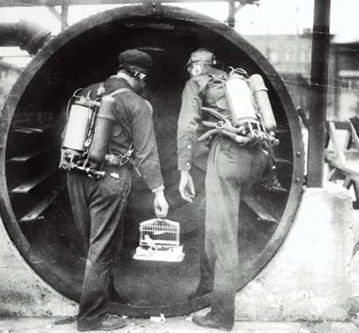Gas Detection Evolution: From Canaries to Portable Real-Time Devices
Working in confined spaces present three kinds of hazards: flammable or explosive atmosphere; oxygen-deficient or oxygen-enriched atmosphere; and atmosphere with a high concentration of contaminants. In poorly ventilated spaces, atmospheric contaminants build up to hazardous levels very fast and pose an immediate threat to life. To eliminate potential dangers while working in underground mines, tunnels, shafts, and other environments with confined spaces, it is important to use the right testing equipment.
Do you know that in the early days canaries and mice were used for detection of life-threatening gases, such as CO2 (carbon dioxide), CO (carbon monoxide) and CH4 (methane)? The exposure to a high concentration of harmful gases would completely change their behavior, signaling the miners to exit the tunnel immediately.
In 1815, the invention of the Davy Safety Lamp for use in flammable environments, like coal mines, was life-saving! The lamps were equipped with a metal gauge to measure the flame. If flammable gases were present, the flame burned very high with a blue tint. The safety lamp was placed on the ground to detect denser than air gases. The lamp flame would be put out at the 17% of oxygen level, which provided an early indication of the hazardous environment.
Another method of testing the environment became available around the early 20th century. Before the invention of electronic equipment, carbon monoxide used to be detected with the help of chemically infused paper that changed its color to black when exposed to it.
In 1927, Dr. Oliver W. Johnson created the first Catalytic LEL Combustible Gas Sensor to be used in the Combustible Gas Indicator. Interferometers, LEL and oxygen monitors with alarm, watch-type, portable, single- and multiple-gas monitors are the revolutionary instruments that dominated the market for years and are still popular.
So what’s crème de la crème in gas detection today? Real-time gas detectors! In March 2016, Honeywell introduced the BW Clip Real-Time Gas Detectors that come in two-year versions for hydrogen sulfide, carbon monoxide, oxygen and sulfur dioxide, and three-year versions for hydrogen sulfide and carbon monoxide. The key features that make them most desirable are: they are portable, lightweight, hibernatable, and are maintenance-free, as there is no need for sensor replacement and battery re-charge. These disposable gas monitors are the first ones to have a real-time display. The benefit of a real-time display is that it provides an instant gas reading even in non-alarm conditions. Continuous monitoring of gas concentration levels and identifying changes in atmospheric conditions are essential for making informed safety decisions.
The BW Clip Real Time Gas Detector is compatible with the IntelliDoX instrument management system: users can bump, calibrate or configure their detectors, as well as put detectors into a hibernation mode when not in use, to extend the life of the monitor. This is the most economical real-time data display device on the market.
Below is a list of the new BW Clip Real Time Monitors and an overview of their range of measuring:| 2-YEAR REAL-TIME DETECTORS | Model | Default Alarm Setpoints | Alarm Setpoints Range | Measuring Range |
|---|---|---|---|---|
| Hydrogen Sulfide H2S | BWC2R-H | 10-15 ppm | 1.6–20 ppm | 0-100 ppm |
| Hydrogen Sulfide H2S | BWC2R-H510 | 5-10 ppm | 1.6–20 ppm | 0-100 ppm |
| Carbon Monoxide CO | BWC2R-M | 35-200 ppm | 5–200 ppm | 0-300 ppm |
| Carbon Monoxide CO | BWC2R-M25100 | 25-100 ppm | 5-200 ppm | 0-300 ppm |
| Carbon Monoxide CO | BWC2R-M50200 | 50-200 ppm | 5-200 ppm | 0-300 ppm |
| Oxygen O2 | BWC2R-X | 19.5%-23.5% | 18%-25% | 0%-25% |
| Sulfur Dioxide SO2 | BWC2R-S | 5-10 ppm | 2-20 ppm | 0-100 ppm |
| Sulfur Dioxide SO2 | BWC2R-S24 | 2-4 ppm | 2-20 ppm | 0-100 ppm |
| 3-YEAR REAL-TIME DETECTORS | Model | Default Alarm Setpoints | Alarm Setpoints Range | Measuring Range |
| Hydrogen Sulfide H2S | BWC3R-H | 10-15 ppm | 1.6-20 ppm | 0-100 ppm |
| Carbon monoxide CO | BWC3R-M | 35-200 ppm | 5-200 ppm | 0-300 ppm |
If you have questions or need help finding the right gas detector, please feel free to call us at 800-829-9580, or visit us online at pksafety.com. Follow us on Twitter: @PKSafetydotcom.
Check out our blog post on gas detection: WHAT’S NEW IN THE WORLD OF RKI GAS MONITORS?
Related Searches
Gas Monitors,
Confined Space Gas Monitor,
4 Gas Monitor
Recent Posts
-
Promoting Safety: National Work Zone Awareness Week is April 15-19, 2024
Each year, the National Work Zone Awareness Week (NWZAW) places the spotlight on the importance o …Apr 11th 2024 -
Understanding 4 Gas Monitors: How They Work & Why They Are Important
In today’s increasingly dynamic industrial landscape, 4 gas monitors have emerged as critical com …Apr 8th 2024 -
April Showers Require Workers to Wear Hi-Vis Safety Rain Gear
While April showers bring May flowers, they also bring challenges, particularly for those working …Apr 1st 2024





